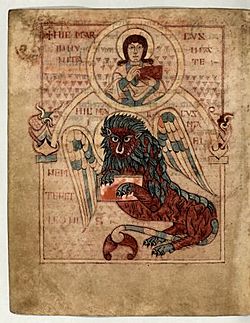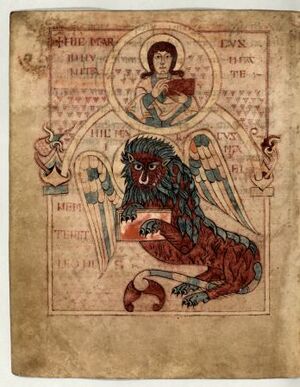Book of Cerne facts for kids
Quick facts for kids The Book of Cerne |
|
|---|---|
| Cambridge, Cambridge University Library, MS Ll.1.10 | |

Book of Cerne, f. 12v: Gospel of St Mark miniature, showing the winged Lion of St Mark
|
|
| Type | Prayer book |
| Date | c.820–840 |
| Place of origin | Mercia, Dorset, Cerne Abbey |
| Language(s) | Latin, with Old English |
| Material | Parchment, ink |
| Size | 285 × 225 (230 × 195) mm |
| Script | Insular minuscule |
| Contents | Gospel extracts; prayers and hymns; Lorica of Laidcenn; Breviate Psalter; Harrowing of Hell |
| Illumination(s) | 4 full-page miniatures of the Evangelists in colours. Initials in gold, some zoomorphic; interlace initials |
| Additions | Glosses in Old English |
| Other | Member of the Southumbrian 'Tiberius Group' |
The Book of Cerne is a very old prayer book from the early 800s AD. It was made in England, likely in the Mercian region. This special book is written mostly in Latin, but it also has parts in Old English. It's one of only a few prayer books from that time.
The Book of Cerne is a collection of different religious texts. It includes parts of the New Testament Gospels, prayers, hymns, and even a short version of the Psalms. It also contains a unique story called the Harrowing of Hell. All these texts were put together for people to use in their private prayers and thoughts. Experts believe it is one of the most detailed and beautiful books from its group. It shows influences from Irish, Anglo-Saxon, and European art and writing styles.
This book explores ideas about the "Communion of Saints". This means the spiritual connection between all Christians, both living and those who have passed away, and with Jesus Christ. It also talks about themes like forgiveness, salvation, and new beginnings, like those found in baptism.
Contents
What's Inside the Book of Cerne?
The main part of this old book has six different sections. They are all connected by their ideas.
An Old English Prayer
This section is an introduction to the book. It's written in an old form of English, probably from Mercia. It encourages the reader to pray and highlights the idea of unity among Christians. This prayer is thought to be the oldest known example of prose (regular writing, not poetry) in Old English.
New Testament Gospel Stories
This part has selections from the Gospels of Matthew, Mark, Luke, and John. These sections focus on the suffering and Resurrection of Jesus. Before each Gospel section, there is a beautiful, full-page picture of the Evangelist (the writer of that Gospel).
A Special Poem
On one page, there is a poem written in Latin. Each line of the poem uses a different color of ink, like red, purple, blue, and orange. This poem mentions a bishop named Ædeluald. It seems this poem was added to fill an empty page in the book.
Prayers and Hymns
This section contains 71 different prayers and hymns. They are written in Latin, but some have notes in Old English. Some of these prayers show Irish influences. A few also talk about Mary, the mother of Jesus.
A Shortened Psalter
This part is a collection of shorter verses from the Old Testament Psalms. They are arranged to form a continuous prayer. The Book of Cerne has 272 verses, which is fewer than other similar books. This shorter version might show Irish influences. This section begins with a Latin note saying, "Bishop Ædeluald has worn out these lines of proof."
The Harrowing of Hell Story
This text tells an extra story not found in the main Bible. It describes how Jesus went into Hell after his Crucifixion of Jesus but before his resurrection. He went there to save good people who had died before him. This story is told as a dialogue between a narrator, Adam, and Eve, with a choir. It's one of the earliest known versions of this story.
Later Additions to the Book
Over time, two other sets of texts were added to the Book of Cerne. These additions date from the 1300s to the early 1500s. They are related to the Benedictine Cerne Abbey in Dorset, which is how the book got its current name. The first set of additions includes documents about the Abbey. The second set includes more religious texts and a list of holy objects kept at the Abbey.
The Handwriting (Script)
The main handwriting in the Book of Cerne is a special type called Southumbrian/Mercian minuscule. It's a neat and high-quality style of writing. Even though most of the text uses this smaller, cursive script, some larger, more decorative letters are used to highlight important parts or show where to pause. Experts believe that only one person wrote the original Anglo-Saxon text in this book.
Pictures and Decorations
The Book of Cerne is beautifully decorated with pictures and designs. It has four full-page pictures, along with many decorated letters and patterns. The decorations include animal shapes, plants, woven patterns (interlace), and curvy designs. The artists used many colors like gold, purple, blue, red, yellow, green, white, and black.
The Evangelist Pictures
The Book of Cerne has four amazing full-page pictures of the Evangelists: Matthew, Mark, Luke, and John. Each picture comes before the section of their Gospel. They are all similar in style but have small differences.
Each picture shows the Evangelist from the waist up in a circle at the top. They usually hold their Gospel book. Below them, inside an archway, is their special animal symbol. These symbols come from a vision in the Old Testament Book of Ezekiel. Each animal symbol is winged and has a halo, and they also hold a book. Each picture also has two Latin sayings written in capital letters, one at the top and one at the bottom.
Matthew's Picture
In Matthew's picture, he is shown with his right hand raised in a blessing gesture. His symbol is a full-figure angel standing. This picture is more detailed than the others, showing its importance as the first Gospel. It includes special Celtic designs.
The Latin sayings are:
- Top: "+ HIC MATHEVS IN HUMANITATE" ("Here Matthew is in his human form")
- Bottom: "+ HIC MATHEVS IN ANGELICA ASSPECTV VIDETVR" ("Here Matthew is seen in his angelic aspect")
Mark's Picture
In Mark's picture, he also blesses with his right hand. His symbol is a winged lion standing on its back legs. The columns in this picture rest directly on the ground, without bases.
The Latin sayings are:
- Top: "+ HIC MARCVS IN HUMANITATE" ("Here Mark is in his human form")
- Bottom: "+ HIC MARCVS IMAGINEM TENET LEONIS" ("Here Mark has the image of a lion")
Luke's Picture
Luke is shown holding a pen and an open Gospel book. His symbol is a winged, horned calf or ox standing on its back hooves. The calf's upper body seems to be influenced by other European art styles. Like Mark's, the columns here rest directly on the ground.
The Latin sayings are:
- Top: "+ HIC LUCAS IN HUMANITATE" ("Here Luke is in his human form")
- Bottom: "+ HIC LVCAS FORMAM ACCEPIT VITULI" ("Here Luke has taken the shape of a calf")
John's Picture
John is shown holding his closed Gospel book with both hands. His symbol is a full-figure eagle, looking to its right. The columns in this picture have detailed, decorative faces and plant designs.
The Latin sayings are:
- Top: "+ HIC IOHANNIS IN HUMANITATE" ("Here John is in his human form")
- Bottom: "+ HIC IOHANNIS VERTIT FRONTEM IN AQVILAM" ("Here John has transformed into the likeness of an eagle")
Doodles in the Margins
Around the edges of the pictures for Matthew, Luke, and John, you can find small drawings or "doodles" of their animal symbols.
Decorated Letters and Designs
Throughout the book, there are many other decorative features. These include large, fancy letters at the beginning of sections and smaller decorated letters within the text. The designs often feature animal shapes, sometimes looking like "brontosaurus-like" creatures, and plant patterns. These designs show influences from Irish and Byzantine art.
The Book's Journey Through History
After it was made in the 800s, the exact journey of the Book of Cerne is a bit of a mystery. It's thought that the book might have been moved to a safer place, perhaps Worcester, to protect it from Viking raids.
Even though later texts about Cerne Abbey were added to the book, it's not certain if the book was ever actually kept at that monastery. We do know that by 1697, these documents from Cerne Abbey were attached to the original old book.
The first clear record of the Book of Cerne comes from a list of books owned by John Moore, who was a bishop. After he died in 1714, King George I bought his entire library, including the Book of Cerne, for a lot of money. The King then gave this whole library as a gift to Cambridge University on September 20, 1715, where it remains today.
Images for kids


